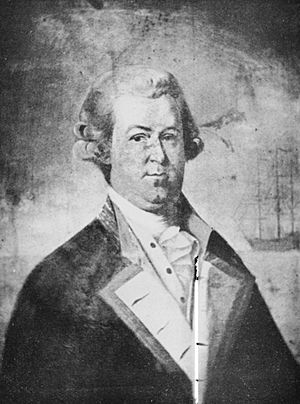Philip Carteret facts for kids
Quick facts for kids
Philip Carteret
|
|
|---|---|
 |
|
| Born | 22 January 1733 Trinity Manor, Jersey |
| Died | 21 July 1796 (aged 63) Southampton, England |
| Place of burial |
All Saints' Church, Southampton
(Destroyed by WW2 bombing) |
| Allegiance | |
| Service/ |
|
| Years of service | 1747–1794 |
| Rank | Rear Admiral |
| Commands held | Swallow Endymion |
| Relations | Carteret family |
| Signature | |
Philip Carteret (born January 22, 1733, died July 21, 1796) was a brave British naval officer and explorer. He was also known as the Seigneur of Trinity, which meant he was a lord of a special area in Jersey. Philip Carteret took part in two big circumnavigation trips for the Royal Navy. A circumnavigation is a journey completely around the world. These amazing voyages happened between 1764 and 1769.
Contents
Philip Carteret was born at Trinity Manor on the island of Jersey. His parents were Charles de Carteret and Frances-Mary S. Paul.
He joined the navy in 1747 when he was just 14 years old. His first ship was the Salisbury. Later, from 1751 to 1755, he served under Captain John Byron. Between 1757 and 1758, he was on the Guernsey in the Mediterranean Sea.
First Voyage Around the World
Carteret became a lieutenant on the Dolphin. He joined Captain Byron on a journey to sail around the world. This trip lasted from June 1764 to May 1766. It was a huge adventure and helped him prepare for his own command.
Leading His Own Expedition
In 1766, Philip Carteret was promoted to commander. He was given command of HMS Swallow. His mission was to sail around the world again, this time alongside the Dolphin, which was led by Samuel Wallis.
Discoveries on the Journey
Soon after sailing through the Strait of Magellan, the two ships got separated. This meant Carteret had to continue his journey alone. During this voyage, he made several important discoveries:
- He found Pitcairn Island, which is famous for being settled later by mutineers from the HMS Bounty.
- He also discovered the Carteret Islands, which were named after him.
- In 1767, he found a new group of islands called the Duke of York Islands. These islands are located between New Ireland and New Britain in what is now Papua New Guinea.
- He also rediscovered the Solomon Islands, which had first been seen by a Spanish explorer in 1568.
- He found the Juan Fernández Islands again, which were first discovered in 1574.
Returning Home
By the time he was heading back to England, Carteret was very sick. Luckily, Lieutenant Erasmus Gower was a great help. For much of the trip, Gower was the only healthy person on board Swallow who could navigate the ship. Carteret finally arrived back in England on March 20, 1769.
Life After Exploration
After his long voyage, Carteret returned to Jersey. He became the Seigneur of Trinity and got involved in local politics. In 1771, he was promoted to post-captain.
On May 5, 1772, he married Mary Rachel Silvester in London. They had five children, and four of them lived to be adults.
- Their second son, Philip Carteret Silvester, followed his father into the navy. He later inherited a special title called a baronetcy.
- Their daughter, Elizabeth Mary, later married William Symonds, who was an important ship designer for the navy.
Challenges and Later Service
Philip Carteret's health was badly affected by his difficult voyage of exploration. He didn't receive much recognition or reward from the navy leaders. It was hard for officers to get promoted back then without powerful friends, and Carteret didn't have many. Also, before his trip, he had complained that the Swallow was not a good ship for such a long journey. Because of this, his requests for a new ship in 1769 were ignored.
He was put on half-pay, which meant he only received half his usual salary. He helped other officers by asking for their half-pay to be increased, but it didn't help him personally. In 1773, his travel journals were published in a book called An Account of the Voyages undertaken by Byron, Wallis, Carteret and Cook. However, the editor, John Hawkesworth, changed a lot of what Carteret had written. So, Carteret wrote his own correct version, but it wasn't published until 1965.
Finally, on August 1, 1779, he got a new ship, HMS Endymion. Despite facing problems in the Channel, off Senegal, and in the Leeward Islands (where he almost died in a hurricane), he reached the West Indies as planned. Even though he helped capture four enemy ships, he was later paid off, and the Endymion was given to another captain.
All his requests for another ship were turned down. In 1792, he suffered a stroke. He retired to Southampton in 1794 with the rank of rear admiral. He passed away there two years later.
Burial and Legacy
Philip Carteret was buried in the catacombs of All Saints' Church, Southampton. Sadly, this church was destroyed by German bombs during World War II in 1940. In 1944, the bodies buried there, including Carteret's, were moved and reburied at Hollybrook Cemetery in Southampton.
See also
 In Spanish: Philip Carteret para niños
In Spanish: Philip Carteret para niños
- European and American voyages of scientific exploration
Images for kids


